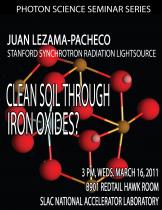Speaker: Juan Lezama-Pacheco, Stanford Synchrotron Radiation Lightsource
Program Description
Uranium, a naturally occurring element found in rock, soil and water, is a toxic element and can affect the normal functioning of the kidney, brain, liver and heart. To avoid human exposure, it's important to remove uranium from soil and sediment in areas where it is highly concentrated. In this lecture, Juan Lezama-Pacheco will discuss a possible mechanism in which uranium incorporates into the iron oxides, and could result into novel means of removing uranium from soils and sediments. Fe-(oxyhydr)oxides, among the most important metal-scavenging phases in soils and sediment, undergo structural and compositional transformations at oxic-anoxic transition zones, where opposing gradients exist of reduced iron and sulfide with oxygen. Recent X-ray absorption fine structure spectroscopy and X-ray scattering studies indicate that, with synthetic Fe-(oxyhydr)oxides, a complex set of uranium chemical states results in the reductive transformation of uranium(VI) and ferrihydrite, having important consequences on long term fate and transport of this element. The work also suggests that bioremediation strategies can drive uranium sequestration not only through direct reduction of uranium (formation of stable phases), but also through iron redox cycling (e.g. incorporating in iron oxides), a highly desirable outcome.





